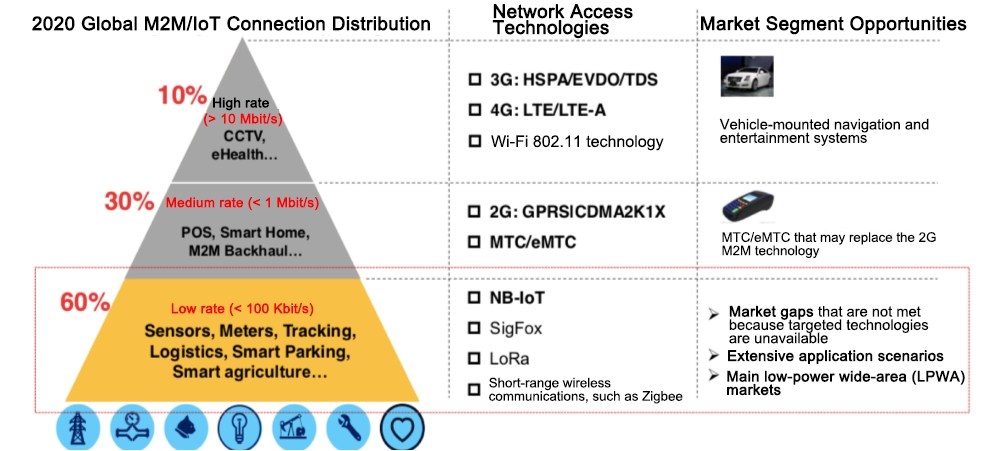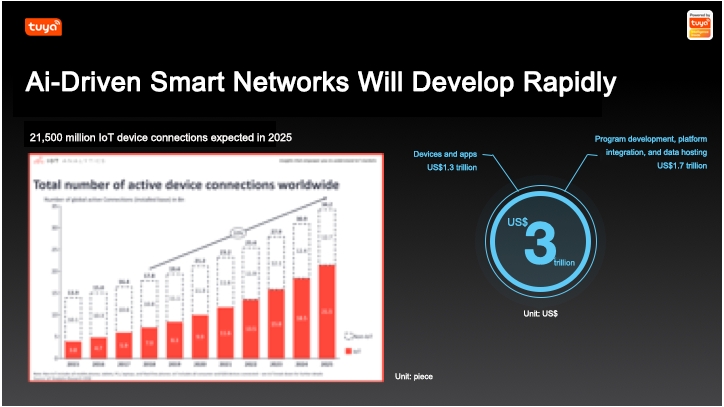About IoT
Introduction
Definition
Internet of Things (IoT) uses sensors, chips, and wireless modules to interconnect all things for information exchange and communications. It is an extension of the Internet that uses computers and mobile terminals to interconnect people.
Elements
Devices with network connection capabilities
Cloud services (data monitoring, storage, and analysis services and data security services)
Control terminals: apps, cloud, and smart speakers such as Google Home and Amazon Echo
Phases
Sensing and control
Scene association
Robot/artificial intelligence (AI)
DCM Architecture

Industry Overview
Rapid Increase in Device Connections
In 2018, the number of IoT connections in China increased rapidly. A report from Counterpoint, a well-known market research company, showed that the number of IoT connections of three major Chinese telecom operators took up more than 60% of global cellular IoT connections in 2018, and this share is expected to be retained by 2025.

IDC estimated that IoT will create a value of US$1.46 trillion by 2020 and generate a large number of opportunities in various market segments.


Promising and Challenging 5G Era
5G has become the hottest topic in the technical world. In 2019, Ministry of Industry and Information Technology (MIIT) issued temporary 5G licenses. This started the 5G era.
Before commercial application, 5G is in a wild speculation period just like other new technologies. Typical operators, however, are still very careful about making 5G infrastructure investments.
According to 3GPP's work progress, established 5G standards focused on Enhanced Mobile Broadband (eMBB). This is also the focus of commercial applications in 2019 and 2020. However, eMBB mainly applies to the mobile Internet and has limited supports for IoT applications. Ultra-Reliable Low-Latency Communication (URLLC) and Massive Machine Type Communication (mMTC) are core technologies for applying 5G to IoT. However, these two technologies are not standardized yet and require time for commercial application. Therefore, it takes time for boosting the IoT development with 5G.
Cloud, Edge, and Device Collaboration, and Further AI+IoT Integration
The edge layer is added to the original four-layer architecture because edge computing has become more and more important in IoT businesses. Edge computing, cloud computing, and device computing form a collaborative system that offers reliable, cost-effective IoT application solutions based on user scenes, resource constraints, and business timeliness. Cloud computing vendors, IT vendors, operators, and virtual industry vendors have reached a consensus on using IoT solutions for cloud, edge, and device collaboration even though they have different opinions about edge computing, edge node positions, and edge computing capabilities.
We believed that the combination of AI and IoT would make a big difference according to the Overall Industrial Report of the Chinese IoT Industry in 2017 and 2018. In 2019, AI giants were exploring how to use AI to empower industries of various national economic sectors, and the integration with IoT is crucially important. AI has integrated with multiple IoT layers, including the device, edge, and cloud layers.
Many technical companies, such as Hikvision, Megvii, and Horizon Robotics have released IoT-related platforms and products. The combination of AI and IoT will implement more products and services and bring more IoT technical solutions into reality.

Last updated
Was this helpful?